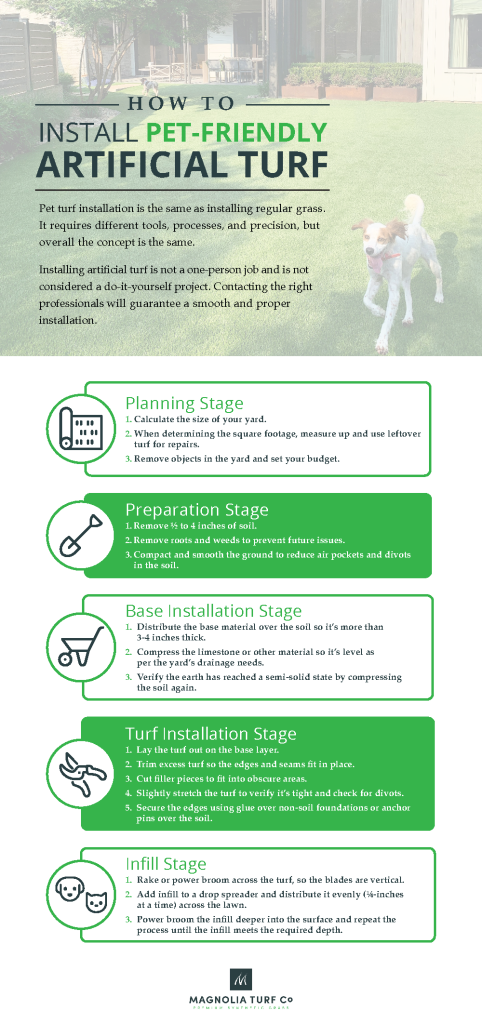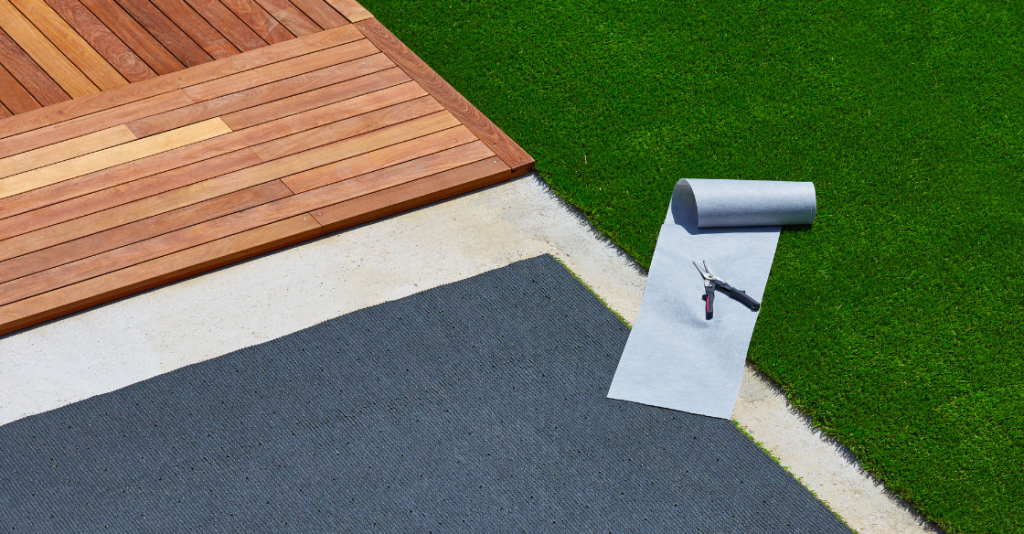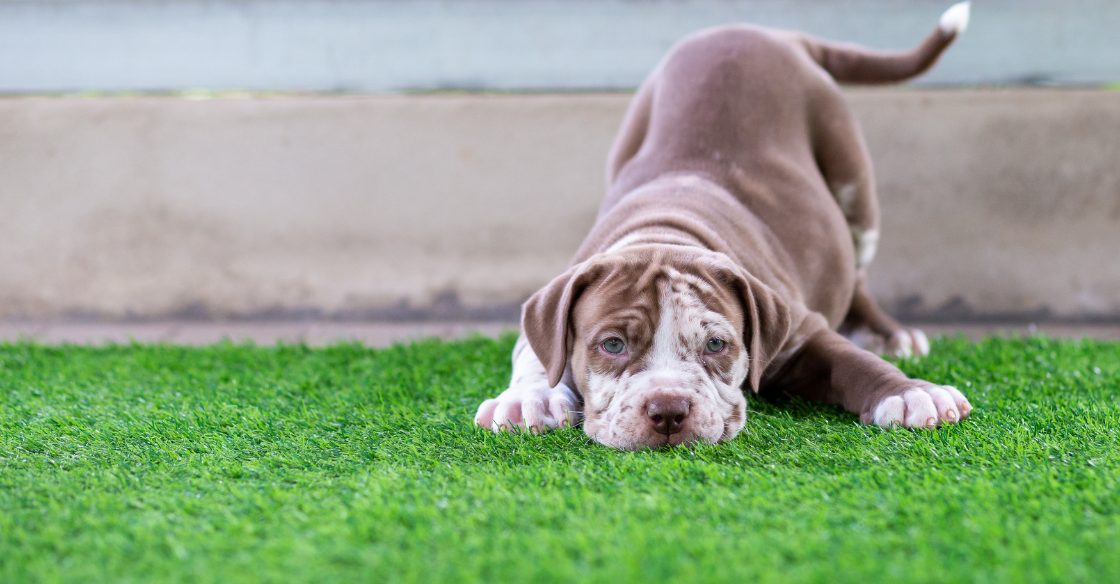If you’re a pet owner, you’ve probably struggled to maintain a pristine lawn. From brown patches to worn-out areas that refuse to grow back, keeping natural grass in great shape can feel impossible with furry friends around. Add unexpected weather like heavy rain or intense heat, and maintaining a lush yard becomes a constant battle. But there’s an alternative: artificial turf installation.
Over the years, pet owners have increasingly turned to synthetic turf for a no-fuss, durable solution to pet-related lawn damage. Not only does pet-friendly artificial grass offer a natural and vibrant appearance, but it’s also entirely safe for your pets and family, no matter the weather.
Whether you’re considering artificial turf installation for your pets or exploring it for the first time, this guide will answer your questions.
What Is Pet-Friendly Artificial Grass?
Gone are the days when synthetic grass was little more than green plastic rolled over concrete. Today’s pet-friendly turf is an entirely different product. It’s a low-maintenance, highly durable solution that mimics natural grass’s look and feel while being impervious to fading and wear.
Magnolia Pet Turf is a standout example of synthetic turf designed for pets. It combines lifelike aesthetics with unparalleled functionality, ensuring a safe, clean, and vibrant lawn for your family and pets. We’ve added antimicrobial protection using Microban® technology, which inhibits the growth of bacteria, mold, and mildew. This keeps your turf cleaner and safer, reducing odors and increasing its lifespan.
Additionally, Magnolia Turf Co. uses Envirofill infill, which replaces traditional silica. Envirofill adds stability to your lawn and provides added protection with its Microban infusion. This advanced technology ensures that your synthetic lawn remains fresh, safe, and visually appealing for years to come.
How to Install Pet Turf

Installing synthetic turf for pets involves a multi-step process that requires careful planning and execution. While installing synthetic grass may sound straightforward, achieving a seamless, durable installation is best left to professionals.
Here’s a breakdown of the five stages of pet turf installation:
1. Planning Stage
Pet turf is designed to be durable, easy to maintain, and aesthetically pleasing. During the planning stage, consider your yard’s size, drainage needs, and any permanent obstacles. Drainage is especially critical for pet turf, as it reduces odors and prevents microbial growth.
Start by calculating the square footage of your yard. Always round up to ensure you have enough material. You can use leftover turf for repairs or as filler pieces for hard-to-reach spots. Identify obstacles like:
- Sprinkler systems (remove or cap them)
- Trees and shrubs
- Concrete pathways
- Garden beds
Determine which obstacles can be removed and which will require custom-cut turf. This stage also involves budgeting for materials, tools, and labor to ensure your turf project stays on track.
2. Preparation Stage
Begin by removing 1.5 to 4 inches of soil from the area where the turf will be installed. Remove roots, weeds, and debris to create a smooth surface. This step is crucial for preventing future problems like shifting or unevenness.
Compact the ground to eliminate air pockets. Make sure the slope facilitates proper drainage if the area naturally slopes. Install a proper drainage system for flat surfaces to keep the turf dry and odor-free.
3. Base Installation Stage
The base layer is the foundation of your synthetic lawn. While many companies use decomposed granite, commercial turf installations benefit from a limestone base. Limestone allows for faster drainage, making it ideal for areas with frequent pet activity.
Spread the base material evenly and compact it to create a stable foundation. Allow the base to settle for a day or two before compressing it again to ensure durability. This step ensures your artificial turf installation will remain level and long-lasting.

4. Artificial Turf Installation
Lay the turf carefully over the base layer, ensuring it’s tight and wrinkle-free. Dragging the turf can disrupt the base, so handle it gently. Trim the edges to fit the area precisely and cut custom pieces for tight spaces.
Secure the turf using anchor pins or staples every six inches. For areas with a concrete foundation, glue the edges to secure the turf. Perform a final inspection to ensure the surface is even and free of divots or raised areas.
5. Infill Stage
Infill is a critical component of artificial turf installation. It adds weight to keep the turf flat, supports drainage, and helps blades stay upright for a natural appearance. Envirofill, used by Magnolia Turf, is an excellent choice for pet turf as it’s antimicrobial and highly durable.
Spread the infill evenly across the turf, then brush it into the fibers for optimal coverage. Infill not only enhances the turf’s performance but also provides a springy, comfortable feel underfoot for both pets and people.
Cleaning Artificial Turf for Pets
One of the biggest advantages of synthetic turf is its low-maintenance. Cleaning your pet-friendly turf is quick and straightforward.
- Daily Cleaning: Rinse the turf with a hose to remove dirt and debris. This keeps your lawn looking fresh and prevents odors.
- Weekly Cleaning: Use a turf cleaner like PE-51, provided with Magnolia installations. This bio-engineered cleaner eliminates germs, odors, and bacteria while deodorizing the turf.
- Deep Cleaning: For heavily soiled areas, scrub the turf with a mild detergent and rinse thoroughly. This ensures your lawn remains hygienic and safe.
With these simple steps, you’ll enjoy a clean, fresh lawn year-round with minimal effort.

The Benefits of Pet Turf
Switching to synthetic lawns comes with numerous advantages. Here are some of the top benefits:
1. Cost Savings
While the upfront cost of artificial turf installation is higher than natural grass, it pays off in the long run. You’ll save on water bills, fertilizers, and lawn equipment, making it a cost-effective solution over its 15-year lifespan.
2. Easy Maintenance
Say goodbye to mowing, watering, and weeding. With pet-friendly turf, maintaining a beautiful lawn is as simple as a quick spray with a hose.
3. Year-Round Aesthetics
Unlike natural grass, synthetic turf stays vibrant and lush regardless of weather conditions. Whether it’s heavy rain or intense heat, your lawn will maintain its perfectly manicured look.
4. Pet-Friendly Features
Magnolia Turf products are designed with pets in mind. The built-in drainage system prevents puddles, and the antimicrobial protection keeps the turf clean and odor-free. Plus, no mud means no dirty paw prints indoors!
Pet-Friendly Artificial Turf in Dallas
If you’re considering pet turf installation for your Dallas home, the friendly and knowledgeable team at Magnolia Turf Co. Dallas is standing by. We pride ourselves on delivering the highest quality pet turf on the market with unbeatable customer service.
Contact us today to learn how our pet system transforms your yard into the perfect pup paradise.